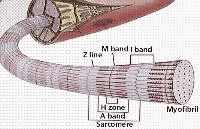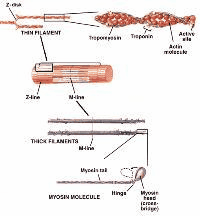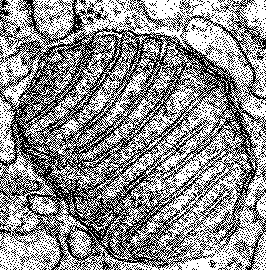
How Do Muscles Work?
What Are Muscles Made Of?
Muscles
are the contractile tissue of the body, and produce all movement, and
circulation in the body. One muscle fibre is a cell and is composed of
a number of thick and thin filaments. The thick filaments are made of
a protein known as myosin and the thin filaments of a protein called
actin. These are arranged to form a three dimensional cylindrical
structure, the fibre. This arrangement has units along it length known
as sarcomeres and it is the sarcomere that is the contractile unit of
the muscle cell or fibre. Within them, are supporting structures to
generate energy, the mitochondria and some fuel stores. There is also a
network of channels within the muscle to transmit signals from the
surface throughout the muscle (the sarcoplasmic reticulum). Individual
cells are linked together by fibrous tissue, the fascia and tendons to
join muscle to bones. Muscles are rich in arteries and veins to carry
fuel and oxygen to the muscles and veins to carry waste products and
carbon dioxide away. Muscles are the meat which we eat, and the red
colour is due to another iron rich protein (myoglobin) which can store
oxygen. Muscles also contain a temporary store of energy in the form of
creatine, and some fat and a starch (glycogen). Strength training and
high intensity exercise can increase the cross sectional area (csa) of
a muscle. The outward appearance of this is generally larger looking
muscles and this increase in muscle csa is directly related to
increases in strength and power.
How do Muscles Contract?
When
you want to move, electrical impulses come from the brain, down through
the spinal cord and are transmitted through the motor nerves to the
muscles. At the junction between the nerve end and the muscle (the
motor end plate), chemical signals are released from the nerve endings
(acetylcholine). This binds to a key on the surface of the muscle (the
receptor). The binding of this chemical to the receptor causes calcium
to enter the muscle cell, and this enables the troponin proteins to
move the myosin up the actin molecule. This causes the functional unit,
the sarcomere, to shorten and when several of these shorten along the
length of the fibre, the muscle as a whole contracts and shortens. To
release the bond between actin and myosin needs energy, to shorten the
muscle further or to cause it to relax. When the signal for contraction
ends, the calcium is pumped back into the sarcoplasmic reticulum (sr),
and the muscle relaxes. One aspect of fatigue is when there is less
affinity of ATP for myosin (in response to changes in the environment
within the fibre) or there is a slowing of the rate of calcium uptake
by sr after contraction and hence a slowing of relaxation of the
muscle. Another aspect of fatigue is the availability of fuels. Glucose and its availability is extremely important for exercise in
general to continue. To release the bond between actin and myosin needs
energy, to shorten the muscle further or to relax the muscle. When the
signal for contraction ends, the calcium is pumped back into the
sarcoplasmic reticulum, and the muscle relaxes.
How Does the Muscle Get and Use Power?
Muscle
needs energy to contract and as stated previously the ‘universal energy
currency’ of living systems is ATP (adenosine triphosphate). This is
largely produced within mitochondria, organelles which are often
referred to as the ‘powerhouse’ of the cell. The ATP that results is
used to provide the power for the muscle fibres to contract.
Contraction itself (i.e. actual shortening movement) occurs when a bond
is broken between ATP and one of its three phosphate bonds. It is the
energy that is liberated by the breaking of this bond that causes the
movement. Hence ATP is broken down to ADP (adenosine diphosphate). ADP
is reconverted to ATP by donation of a phosphate from another high
energy phosphate store in the muscle, creatine phosphate (CP).
Mitochondria can burn glucose, fats and ketones to make carbon dioxide
and water. Doing so ensures that a greater percentage of aerobic
metabolism can be sustained, i.e. a subsequent slightly greater
availability of oxygen and production of ATP. A diet rich in creatine
has the potential to increase the availability of creatine phosphate,
which can increase high energy phosphate supply during intense
exercise. Mitochondria can burn glucose, fats and ketones to make
carbon dioxide and water. They will do so give an adequate supply of
oxygen.
Exercise Types
Aerobic Exercise
During
the first few seconds of exercise, muscles use internal stores of ATP
and with maximal exercise this is supplemented by high energy phosphate
compounds (CP) as exercise continues this is also supplemented by
burning of glucose which is converted from muscle glycogen and burned
in the mitochondria. If the rate at which energy is demanded is low
then energy production is ‘aerobic’ utilising oxygen.
Anaerobic Exercise
If
the rate at which energy is demanded is high then increasingly this is
supplemented by contributions from anaerobic metabolism. The immediate
consequence is the production of lactic acid in the muscle which
immediately breaks down to lactate and hydrogen ions. Lactate provides
a huge fuel source and hydrogen ions can contribute to fatigue by
interfering with contractile processes and by changing the pH of the
muscle cell. The tolerance for lactate, or more specifically for its
attendant hydrogen ions and decreasing pH is limited. This is a
protection mechanism, as if pH inside the muscle drops too low damage
can occur. However, training can improve tolerance of pH and
maintenance of it within an appropriate range which can allow exercise
to continue. Because tolerance of lactate and its attendant challenges
very high intensity (‘anaerobic’) exercise is of limited duration..
Training can increase both your capacity for aerobic exercise. Repeated bursts of anaerobic exercise can increase the ability to tolerate and metabolize lactate, and can therefore increase the intensity and duration of maximum work.
Training can increase both your capacity for aerobic exercise. Repeated bursts of anaerobic exercise can increase the ability to tolerate and metabolize lactate, and can therefore increase the intensity and duration of maximum work.




